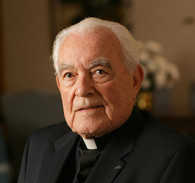
NOTRE DAME, Ind. (CNS) – Holy Cross Father Theodore M. Hesburgh, who led the University of Notre Dame through a period of dramatic growth during his 35 years as president and held sway with political and civil rights leaders, died Feb. 26 at the age of 97.
As the longest serving president of Notre Dame, from 1952 to 1987, Father Hesburgh built the university from a small college primarily known for its prowess on the football field into one of the nation’s premier higher education institutions.
“We mourn today a great man and faithful priest who transformed the University of Notre Dame and touched the lives of many,” Holy Cross Father John I. Jenkins, Notre Dame’s current president, said in a statement. “With his leadership, charism and vision, he turned a relatively small Catholic college known for football into one of the nation’s great institutions for higher learning.
“In his historic service to the nation, the church and the world, he was a steadfast champion for human rights, the cause of peace and care for the poor,” he said.
He was born in Syracuse, New York, to Anne Murphy Hesburgh and Theodore B. Hesburgh, an executive of the Pittsburgh Plate Glass Co.
He was educated at Notre Dame and Rome’s Pontifical Gregorian University. He was ordained a priest of the Congregation of the Holy Cross in 1943 in Sacred Heart Church, today the basilica, on the Notre Dame campus. He received a doctorate in sacred theology from the Catholic University of America in 1945.
He became the university’s 15th president in 1952.
Under his presidency, the university budget grew from $9.7 million to $176.6 million while the endowment expanded from $9 million to $350 million. Enrollment increased from 4,979 students to 9,600 and the faculty expanded from 389 to 950.
In 1967, he oversaw the transference of governance of the school from the Congregation of the Holy Cross to a two-tiered, mixed board of lay and religious trustees and fellows. The school also admitted women to undergraduate programs beginning in 1972.
Father Hesburgh also played an influential role in national and international affairs both during and after his presidency. He held 16 presidential appointments over the years, tackling major social issues including civil rights, immigration reform, peaceful uses of atomic energy, campus unrest, treatment of Vietnam draft evaders and development in the world’s poorest nations.
He was a charter member of the U.S. Commission on Civil Rights when it was created in 1957 by President Dwight D. Eisenhower. He chaired the body from 1969 until 1972 when President Richard Nixon dismissed him over his criticism of the administration’s civil rights record.
The Holy Cross priest also served on President Gerald R. Ford’s Clemency Board, which was responsible for deciding the fate of Vietnam offenders.
As a result of his work on the two commissions, the university developed a law school and the Center for Civil and Human Rights.
Father Hesburgh served on the Overseas Development Council, a private organization supporting interests in developing nations, beginning in 1971 and chaired it until 1982. He led efforts to overcome mass starvation in Cambodia in 1979 and 1980.
During the Cold War in the early 1980s, Father Hesburgh joined a private initiative which sought to unite internationally known scientists and world religious leaders in condemning nuclear weapons.
Father Hesburgh served four popes, including three as the Vatican’s permanent representative to the International Atomic Energy Agency in Vienna from 1956 to 1970. Blessed Paul VI asked him to build the Tantur Ecumenical Institute in Jerusalem, which the university continues to operate. He also served as head of the Vatican delegation attending the 20th anniversary of the U.N.’s human rights declaration in Teheran, Iran, in 1968. He also served as a member of the Holy See’s U.N. contingent in 1974.
